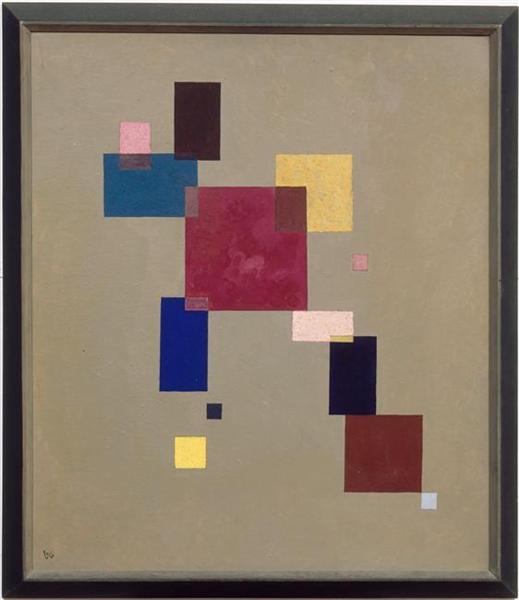Description
The work "thirteen rectangles" (1930) by Wassily Kandinsky is a notable example of its evolution towards an increasingly pure and personal abstraction. This painting, that embodies the essence of the artistic movement that Kandinsky helped to found, reflects his deep understanding of the relationship between form, color and emotion. In the historical context of the art of the first half of the twentieth century, the work is part of the search for new visual languages that break with traditional narratives, exploring the autonomy of painting as a means of spiritual expression.
The composition presents a set of rectangles of various proportions that occupy the surface of the canvas in a seemingly random order, but that reveals a careful calibration by the artist. The rectangles are willing in such a way that they create a sense of movement and dynamism, challenging the conventional static in the pictorial form. The disposition of these geometric forms evokes the work of constructivism and the Bauhaus, currents that considerably influenced Kandinsky throughout his career. This approach to the structure adds to the search for balance and harmony, primary elements in its artistic philosophy.
Color plays a fundamental role in "thirteen rectangles." The palette is vibrant, using strong tones that contrast with each other. However, it is not simply a color game for the color itself; Each tone seems to have a specific emotional resonance, evoking different moods and sensations. This is aligned with Kandinsky's theory about synesthesia, where colors and shapes have the ability to awaken sounds and feelings in the viewer. The interaction of these intense colors gives the work an almost musical quality, which is fascinating for the observer.
In this work, there is a deliberate absence of characters or figurative elements to recognize; Instead, Kandinsky immerses himself in the exploration of the abstract. This decision reflects its belief that art should transcend the representation of tangible reality, thus approaching a visual language that invokes a direct connection between art and spirit. This idea is a conductive thread throughout his work, where he seeks to provoke not only visual contemplation, but also a deep emotional experience.
Although "thirteen rectangles" may not be as recognized as some of its previous masterpieces, such as "composition X" or "improvisation 28", its value lies in experimentation with pure abstraction. In the context of the development of modern art, Kandinsky stands as a pioneer whose contributions to visual language continue to influence generations of contemporary artists. This painting, in particular, can be considered a synthesis of its artistic evolution, a reflection of its incessant search to capture the essence of the spiritual world through form and color.
In conclusion, "thirteen rectangles" of Wassily Kandinsky is presented as a vibrant testimony of the ability of art to evoke deep emotions through the abstract. Through the interaction of geometric shapes and the masterful use of color, the work invites a reflection on the nature of art and its connection with human experiences. This canvas not only challenges our understanding of what painting can be, but also reminds us that, in abstraction, there is a universe of emotional life waiting to be discovered.
KUADROS ©, a famous paint on your wall.
Hand-made oil painting reproductions, with the quality of professional artists and the distinctive seal of KUADROS ©.
Art reproduction service with satisfaction guarantee. If you are not completely satisfied with the replica of your painting, we refund your money 100%.

